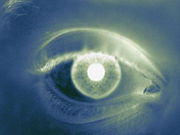Combo of gene therapy, visual stimulation helped part of crushed optic nerve grow back into the brain
TUESDAY, July 12, 2016 (HealthDay News) — A combination of gene therapy and visual stimulation prompts partial regrowth of the optic nerves, restoring some communication between the brain and the eye, according to an experimental study published online July 11 in Nature Neuroscience.
Andrew Huberman, Ph.D., an associate professor of neurobiology at the Stanford University School of Medicine in Palo Alto, Calif., and colleagues used forceps to crush the optic nerve leading to one eye in a group of laboratory mice. They then set about trying to repair the nerve they’d damaged, using different therapies.
Partial regeneration of the optic nerve occurred when researchers used gene therapy to stimulate the mammalian target of rapamycin pathway. The research team also had some success in promoting optic nerve regeneration through visual stimulation, where the mice used only their damaged eye to watch a series of high-contrast moving bars. That therapy promoted some nerve regrowth, the researchers said.
But neither approach alone could re-establish the link between brain and eye. “We found that the neurons would regrow, but not very far,” Huberman told HealthDay. “They would grow towards the brain, but they couldn’t reconnect with the brain.” However, combining both gene therapy and visual stimulation caused a small part of the optic nerve to fully regenerate a connection between the eye and the brain, the researchers found. “When we did that, we saw an incredible synergistic effect,” Huberman said. “The axons not only regrew, but they grew very fast and they regrew all the way back into the brain.”
Copyright © 2016 HealthDay. All rights reserved.








